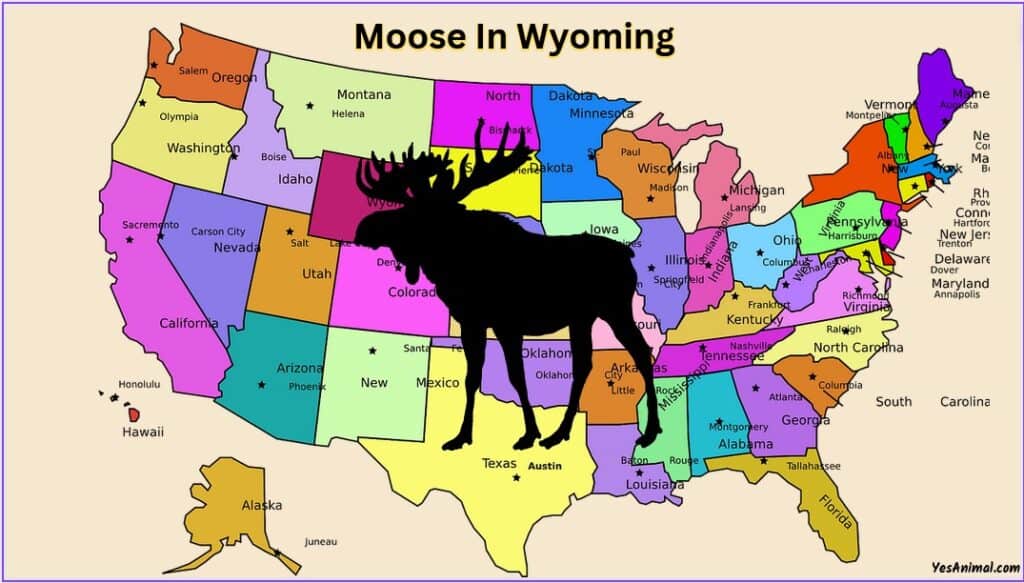Last Updated on September 14, 2023 by Amin Tawar

They are great swimmers and are so tall that it’s almost impossible for them to bend down at grass level. While the male species has 2 antlers, the female ones have white vulva patches on their hindquarters which can be seen without coming too close to them. Yes, we are talking about moose.
Native to the North American continent, moose are home to various states of the country including Wyoming.
Below In this article, I’ve explained everything you need to know about their presence in the state, their population density, their physical traits, and legalities related to hunting these creatures.
Are There Any Moose in Wyoming?
Yes, Moose has an established population in Wyoming. They may not be as common as in other states like Alaska but do have a strong presence in the state.
In general, they prefer habitats with dense forest covers, vegetation, and wetlands with ponds or lakes. Where there is an abundance of trees, aquatic and land plants, leaves, and shrubs.
How Many Moose in Wyoming?
Once present in tens of thousands in population, almost 10,000 in the 1990s, the moose population has drastically declined since then. As per the Wyoming Game and Fish Department, there are just under 3500 moose individuals in Wyoming currently.
It is also important to note that animal population depends on various factors and can change over time. They largely change with respect to habitat availability, the presence of predators, and hunting regulations.
In fact, due to strict hunting regulations, the state has managed to contain its population and raise its numbers slowly but surely.
Where To See Moose in Wyoming?

You can see moose in various places of Wyoming particularly in mountain ranges and river bottom areas. These creatures are typically found in the northwest and western regions of the state with the highest density in Bridger-Teton National Forest which is south of Jackson.
Here visitors flock each year to see moose and other wildlife. Other locations where you could spot them include Grand Teton National Park, Jackson Hole, Bighorn National Forest, and Snowy Range Scenic Byway.
How Big Are Moose in Wyoming?
Moose in each state have few variations in size albeit very small. Typically, they are the largest terrestrial in their ecosystem with few exceptions. A bull will in general weigh anywhere from 500-1400 lbs.
They will measure about 1.6 to 2.1 m in height at the shoulder. Cow on the other hand would weigh and measure smaller than bull which is often the case in other creatures of the wild too.
Also Read About Moose In Washington
When do moose shed their antlers in Wyoming?
Did you know, only bulls have antlers and not cows? Yes, Antlers form the most important distinction between cows and bulls which helps distinguish between each of them in the wild from a long distance.
Typically, moose shed their antlers each year during winter months in Wyoming. The timing can vary based on age, and individual moose health but in general, moose shed between December to April. And it also grows back.
Can You Hunt Moose in Wyoming?
Yes, Hunting of moose is legal in Wyoming provided you obtain a license for the same which even as per the official website can be difficult to obtain as the license is provided through a lottery-based drawing system.
Managed by Wyoming Game and Fish Department, moose license largely depends on the area of the hunt and the sex of the creature. For instance, it is easier to draw cows with fewer preferences than bulls and other moose tags.
As per the latest hunting license application by the Wyoming Game and Fish Department, for a resident of the state, a moose hunting tag costs 157$, and the same for a non-resident of the state costs around 2750$.
It is also important to notice that only 10% of moose licenses are allocated to non-residents. Before you plan your hunting, confirm the requirements for the license and obtain it.
Also Read About Moose In America
Conclusion
And that was everything you need to know about the Moose In Wyoming. I hope this article answered all your queries.
Thank You For Reading!
Our Source For This Guide